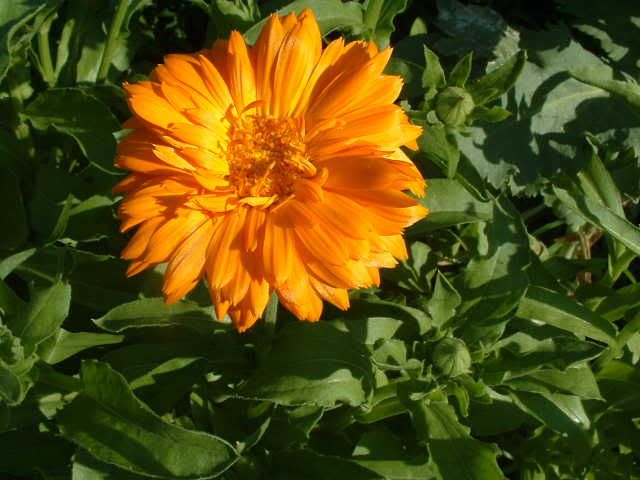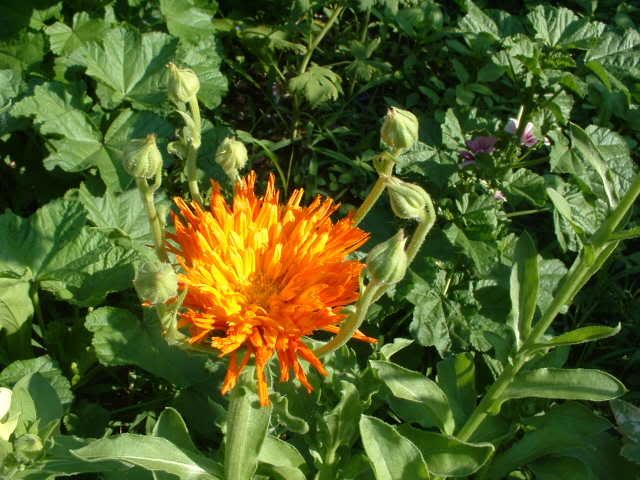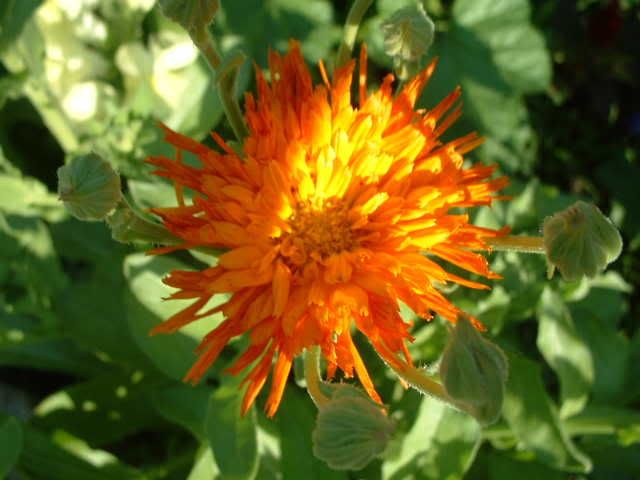

 Since this is the Summer Solstice, I thought I should usher in the season with an appropriately fiery example of something currently blooming in our garden. Emblematic of the sun and summer itself, and representing the best of the fire range of flowers, a Calendula caught my eye. And, oddly enough, it does qualify in the sports department. Bear with me. There is a connection.
Since this is the Summer Solstice, I thought I should usher in the season with an appropriately fiery example of something currently blooming in our garden. Emblematic of the sun and summer itself, and representing the best of the fire range of flowers, a Calendula caught my eye. And, oddly enough, it does qualify in the sports department. Bear with me. There is a connection.The last thing most people who know me would expect me to talk about is sports. But it's a special kind of sport that I have on my mind tonight: what's known commonly known as a sport of nature.
Tonight, as I was out with my camera looking for some newly blooming subjects, I spotted a Calendula officianalis the likes of which I hadn't seen previously. There, amongst a few clumps of budding and blooming flowers, was a most unusual specimen ... not just a smallish bloom, just opening, but also a corolla of seven tiny buds, all attached to the base of the central flower. This is a sport. What struck me as most unusual is that Calendula officianalis is a pure species, not a hybrid prone to cross pollinating and producing interesting offspring. So this particular flower got me to wondering about how this one came about. The best I could come up with was that it's a spontaneous mutation, because it so closely resembles most of the Calendulas we have in the front bed, but with one important distinction ... that odd cluster of those seven buds.
Sports of nature are really not that uncommon in the ordinary garden. Peppers, for example, are notorious for their ready ability to sport, which is why, as a general rule, it's not a good idea to save pepper seeds from previous years' harvests to replant. The result may look like a luscious bell pepper but be as fiery as a jalapeño or a serrano pepper! And, if it weren't for a plant's propensity to sport and produce interesting new varieties, we wouldn't have many of the currently available varieties of flowers and vegetables that we take for granted. Those tomatoes you have in your garden are most likely the result of a sport at one point or another ... or those peppers .. or any number of other cross-bred varieties. Sports are a good thing! Just ask Gregor Mendel about his experiments with sweet peas, that generated a whole science from just a few flowers ...
In fact, we look forward each year to summer when we find many odd examples of Celosia species popping up volunteer around the garden, some with the more feathery plumosa characteristics, some of the cristata or 'cockscomb' variety, and some who are trapped strangely between the two worlds in a fantastical sort of way. They are the result of a long time presence of the basic species in the garden. Some of the very first annuals we planted and saw return as self-seeding volunteers were various varieties of Celosia. Over time, they have cross-pollinated, mutated or otherwise devolved into odd parodies of their original incarnations. Call it the gene pool's revenge if you like, but flowers are going to do what flowers naturally do, given the right circumstances. And that's precisely what I think this particular Calendula is doing now. I'm going to keep close watch on this plant and see if (m)any of the additional buds actually open ... though the thought of seeing blooms all the way around that first one does sound tantalizing, should it come to pass.
Now, for those of you perhaps not familiar with the Calendula species, it's really a great annual to have in the garden. Usually one year's successful sowing means that you will see them return faithfully the next spring, provided that you let them drop their seeds as they will. We tend to take the seed as it matures and toss it about all over the front bed and see where it thrives, which this year, appears to be on the corner bordering the north side of the house. There they shine ... in the main area of the bed, growing between and at the base of the rocks, offering up their sunny, summery hues.
I may not be an ancient Druid or Celt, but our Calendulas are fire enough for this midsummer's eve. And the light really cooperated with me tonight ... as I think these pictures capture their unique glow ....
I'll end with a few brief notes on growing and using Calendula officianalis.
Calendula has a variety of both herbal and culinary uses, ranging from adding the flowers to salads (tasty!) to applications both external and internal. Calendula can be found as an ingredient in many soaps, lotions and even natural deodorant, and have especially noted beneficial properties for the skin. Apparently, it can also be taken internally for a wide variety of gastric ailments, as well as an anti-inflammatory agent. I can't vouch for any of those, but that's what the herbals tell us. In any case, they make a welcome addition to any sunny border, where they can thrive and stake out their territory. We're encouraging them to come up to weed status in the garden here ... they're not picky about soils, do well in dry situations and otherwise just bloom nearly constantly from early summer to fall. You can't ask too much more from an annual ... well, you could, but you probably wouldn't get it.
So, let's hear it for the Summer Solstice! If you're so inclined, go up to the top of that hill, build your bonfire, and thank the sun for coming back for an extended stay. Calendulas are a great reminder of that duty.
NOTES: The top photo is of a "normal" Calendula blooming. The second is the sport. The third is a close up of the sport.
So there, I wrote a post about sports. Now that hockey is done and the Canadians are deprived for another few months. Baseball? Ehhhh, hope you enjoy it. I'll stick to gardening sports any day.









11 comments:
Beautiful colours! LOL IVG -- it is a thesis you've got here. ;) Do keep us informed if those other buds do anything. Like I said at BT, I'm going to have to reread this one again... :-)
No problem! I had to reread it several times myself before I could really hit the publish button.
Just one o'me lil tangents ...
I like your tangents ... :-)
Great post and pictures IVG. So you're a sports announcer now?
You should be a teacher IVG. I hadn't thought about plant mutation in a long time, but you make it sound interesting. I can see why you like plants so much.
As far as hockey and baseball. Tiddlywinks, I say, tiddlywinks.
It's amazing what you can find on goggle.
I don't know why, but the time/date stamp turned out to be my link to the English Tiddlywinks Assc. :)
Cool post, IVG. I know absolutely nothing about gardening but you held my interest throughout the entire thesis. I'm lucky if I don't kill plastic flowers. :)
I'm with Manny. Your writing about gardens and gardening is fascinating, regardless of whether one has any desire to garden or not.
Well hi there Man eegee and Andi! Glad you stopped by and thanks for the kind words about the writing. I had no idea I would tackle that subject last night, but finding that sport in the garden inspired me to address the subject. Oddly enough, tonight while we were doing some weeding (still no rain!), we discovered another Calendula sport very close to the one I pictured last night. They're mutating! I'll keep you folks posted on how that goes ... the new one we found didn't have as many buds, but is doing the same thing...
[url=http://garciniacambogiaselectz.weebly.com]
garcinia cambogia rind extract[/url] is the richest fat burning extract nearby in superstore now a days. Yield upto 10 kg in 1 month. garcinia cambogia select
ugg boots
polo ralph lauren
giants jersey
ugg outlet
ugg boots
ray ban sunglasses
new balance shoes
ugg boots
jordan 8
nike huarache
ugg boots
polo ralph lauren
giants jersey
ugg outlet
ugg boots
ray ban sunglasses
new balance shoes
ugg boots
jordan 8
nike huarache
Post a Comment